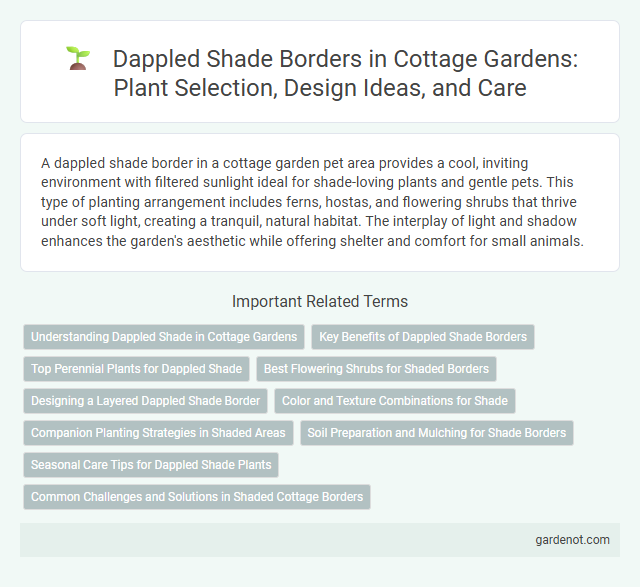A dappled shade border in a cottage garden pet area provides a cool, inviting environment with filtered sunlight ideal for shade-loving plants and gentle pets. This type of planting arrangement includes ferns, hostas, and flowering shrubs that thrive under soft light, creating a tranquil, natural habitat. The interplay of light and shadow enhances the garden's aesthetic while offering shelter and comfort for small animals.
Understanding Dappled Shade in Cottage Gardens
Dappled shade in cottage gardens occurs where sunlight filters through the leaves of trees, creating a soft, speckled light that supports a diverse range of shade-tolerant plants like ferns, hostas, and astilbes. Understanding the microclimate of dappled shade helps gardeners select species that thrive in fluctuating light conditions and retain moisture in the soil. Designing borders with layered planting, combining shrubs and perennials, enhances the natural, romantic charm characteristic of traditional cottage gardens.
Key Benefits of Dappled Shade Borders
Dappled shade borders create an ideal microclimate for shade-tolerant plants, promoting healthier growth and vibrant foliage in cottage gardens. These borders enhance biodiversity by attracting pollinators and beneficial insects, supporting garden ecosystem balance. They also provide year-round structural interest, combining texture and color while reducing water evaporation and soil erosion.
Top Perennial Plants for Dappled Shade
Top perennial plants for dappled shade borders include hostas, astilbes, and lungworts, which thrive under filtered sunlight and provide vibrant foliage and delicate blooms. Ferns such as the Japanese painted fern add texture and depth to shady garden areas, while bleeding hearts offer elegant, arching flowers that brighten the understory. These perennials create a lush, layered effect ideal for cottage garden borders with partial shade conditions.
Best Flowering Shrubs for Shaded Borders
Best flowering shrubs for dappled shade borders include hydrangeas, azaleas, and camellias, which thrive under filtered sunlight and provide vibrant blooms. Other excellent choices are rhododendrons and viburnums, known for their lush foliage and colorful flowers that brighten shaded garden areas. These shrubs create a dynamic cottage garden border, combining texture and seasonal interest in low-light conditions.
Designing a Layered Dappled Shade Border
Design a layered dappled shade border by combining shade-tolerant perennials, shrubs, and groundcovers to create varied textures and heights. Incorporate plants like hostas, ferns, astilbes, and hellebores, which thrive under filtered sunlight and provide seasonal interest. Strategically place taller shrubs at the back, mid-height perennials in the middle, and low groundcovers in front to enhance depth and visual appeal in the cottage garden.
Color and Texture Combinations for Shade
Dappled shade borders thrive with a harmonious blend of color and texture, featuring plants like hellebores, astilbes, and ferns that offer lush foliage and delicate blooms. Incorporating variegated leaves and silver-gray foliage enhances contrast while maintaining softness in shaded areas. Layering different textures, from feathery ferns to bold hosta leaves, creates visual depth and interest throughout the growing season.
Companion Planting Strategies in Shaded Areas
Dappled shade borders in cottage gardens thrive with companion planting strategies that maximize growth and biodiversity by pairing shade-tolerant plants like hostas, ferns, and astilbes with early-blooming bulbs such as snowdrops and crocuses. These combinations improve soil health, deter pests naturally, and enhance visual appeal through varied textures and seasonal interest. Strategic placement ensures that taller plants provide filtered light, benefiting lower-growing companions and creating a harmonious, sustainable shaded garden ecosystem.
Soil Preparation and Mulching for Shade Borders
Soil preparation for dappled shade borders involves loosening the soil to improve aeration and drainage while incorporating organic matter such as well-rotted compost or leaf mold to enrich nutrient content. Applying a 2-3 inch layer of mulch, like shredded bark or leaf mulch, helps retain moisture, suppress weeds, and moderate soil temperature in shaded garden areas. Regular replenishment of mulch and careful soil monitoring ensure optimal root health and plant growth in cottage garden dappled shade borders.
Seasonal Care Tips for Dappled Shade Plants
Dappled shade plants in cottage garden borders require careful seasonal maintenance to thrive, including regular watering during dry periods and mulching to retain soil moisture. Pruning spent flowers and removing dead foliage in early spring encourages vigorous growth and prevents disease. Fertilizing with a balanced, slow-release formula in early growing season supports healthy blooms and lush foliage throughout the year.
Common Challenges and Solutions in Shaded Cottage Borders
Dappled shade borders in cottage gardens often face challenges such as excessive moisture retention and limited sunlight, which can lead to fungal diseases and poor plant growth. Choosing shade-tolerant species like hostas, ferns, and astilbes helps address light scarcity while improving soil drainage and mulching reduces moisture-related issues. Regular monitoring for pests and diseases combined with strategic pruning ensures healthy, vibrant plants that thrive in shaded environments.
Dappled shade border Infographic

 gardenot.com
gardenot.com